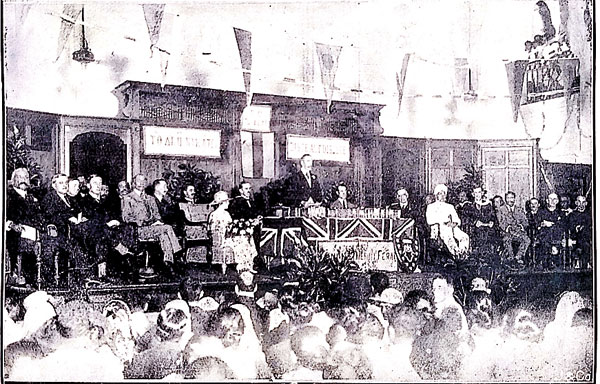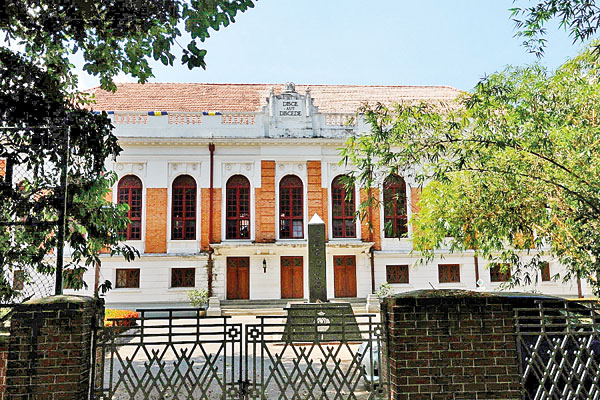Sunday Times 2
Royal College marks 100 years at Reid Avenue
View(s):A centenary in the life of an institution is a long period and calls for much celebration. However, for Royal College, now 188 years old, a grand celebration to mark 100 years at Reid Avenue may not be appropriate.
Rev. Joseph Marsh
It is opportune to look back to the 88 years of Royal College before its life at Reid Avenue and make a brief sketch. In 1831, Rev. Joseph Marsh, a 28-year-old Scotsman, arrived in Ceylon as a missionary of the Church Missionary Society (CMS) in Cotta (Kotte). He was a mathematics and classics tutor and was appointed the headmaster of the CMS. This institute educated and trained young men to be catechists and priests of the Anglican Christian faith.
Rev. Marsh was at the CMS for four years till 1834 and had married a Miss Walker whose family was firmly established in Ceylon. Gov. Horton in appreciation of Rev. Marsh’s ability transferred him as the Acting Chaplain of St. Pauls’ Church at Wolfendhal in 1835.

Governor Sir William Manning addressing the elegantly clad audience. On his right is Principal H.L. Reed, the lady with the bouquet is Mrs. Manning or Mrs. Reed. Sir Ponnambalam Ramanathan may be identified in a turban.
Rev. Marsh started a small school in January 1835 on the verandah of the church. It was called the Hill Street Academy and had about 20 pupils, mainly from the upper-crust Burgher community. The Burghers petitioned Governor Horton for a bigger school to accommodate more of their boys and on January 4, 1836, the Governor named Rev. Marsh’s school as
the Colombo Academy and made him the headmaster.
The Colombo Academy was at San Sebastian, Colombo 12, and was now a State school, and offered the highest level of education so that its alumni could take up positions of importance in the colonial Government.
Richard Morgan, the brightest student under Rev. Marsh and the first Head Boy of the school passed out as an advocate in 1846. He was appointed as a Legislative Councillor in 1857 and acting Chief Justice in 1874/75. In 1863, he became the first Ceylonese in the Governor’s Executive Council, the supreme policy-making body. Morgan along with Muttu Coomaraswamy were the first Asians to be knighted in Britain’s Far Eastern Empire in 1874. The schools’ other illustrious sons who became Legislative Councilors were James Stewart, C.A. Lorenz, Muttu Coomaraswamy, James Peiris, and brothers Ramanathan and Arunachalam Ponnambalam. The latter four were knighted and the last three have halls of residence named after them in the University of Peradeniya.
In the elections in 1866 for the First Municipal Council of Colombo, six of the nine wards were won by former pupils of the school. This was a trend that has continued to this day, where the alumni of this State school have assumed political leadership to govern the affairs of this country.
Rev. Barcroft Boake
With the passing away of Rev. Marsh at the young age of 39, Rev. Barcroft Boake, an Irishman, became the principal in 1842. He had a formidable appearance and brooked no opposition. He is said to have been irascible, where all the different meanings of this word are a description of him. He was to ‘rule’ for 28 years till 1870, and the school was sometimes called Boake’s School or ‘Boake Gedara’. Yet, he was an exemplary Christian and influenced his pupils to cultivate their moral faculties.
Rev. Boake sent the Best students to Queens College, University of Calcutta for higher studies. Amidst much opposition, he even changed the name of the school to the ‘Colombo Academy & Queens College’. It remained so for 10 years till he was forced to revert it to its former name.

The two large rooms on the ground floor of the principal’s bungalow were the boarding, primarily for the sons of planters and Ratemahatmayas who lived in distant outstations. Rev. Boake who occupied the upper floor joined the boarders at 10 a.m. for breakfast and at 4 p.m. for dinner. Rev. Boake was made the Chaplain of the Holy Trinity Church which was built next to the Academy in 1847. He led his pupils to the “Chapel” every morning to this church.
In 1861, at the age of 47, Rev. Boake, a widower, married 28-year-old Agnes Jane, daughter of Rev. Joseph Marsh. Dr. Boake was conferred the Doctor of Divinity in 1969, and after his retirement in 1870, resided in Melbourne, Australia, and was appointed the
first Vicar of Holy Trinity
Church, Balaclava.
The Masters
The Masters were called the Second, Third, Fourth, and Fifth Master, a reference to their hierarchy in the school. Samuel Lister MA who was appointed from England was a stout muscular man, and is remembered as the first Ceylonese schoolmaster to be fined 20 shillings in the Lower Court “for throttling and pummelling a boy”.
In 1846, the appointment of A. Nicholl as the teacher of drawing and design was a significant landmark. He introduced watercolour as a medium of art to Ceylon. During his short stay of four years, he executed about four hundred watercolour paintings on Ceylon subjects.
When Ashley Walker joined as a mathematics and boarding master in 1896, a great change took place. A Cambridge Blue at cricket, he had even played against W.G. Grace. He became captain of the All Ceylon team and was justly called the “Father of Ceylon Cricket”. At the Academy, Walker made the youngsters interested in the game, and together with S. Thomas’ College Sub-Warden, Rev. T. F Falkner, who was also a Cambridge Blue, initiated the Royal-Thomian cricket series in 1880. The Beira Lake stretched beyond the present railway line at Olcott Mawatha up to the bottom of San Sebastian Hill and the two teams rowed across in boats to the Galle Face Grounds, which is today the site of the Taj Hotel. The Academy won this first match by 62 runs. Since then this “Battle of the Blues” is the highlight of the year for both schools.
Name change & motto
As the school was administered by the British Colonial government, the imperial colours of Britian, Royal Gold and Blue were adopted in 1877 as the school colours.
In 1881 by a Royal decree of Queen Victoria, the Colombo Academy was renamed as the Royal College, the first time the use of the word Royal was permitted in the wider realm.
The school Motto Disce aut Discede in Latin means Learn or Depart, a stern watchword to the students that their studies are of primary importance. The complete hexameter is “Aut Disce Aut Discede, Manet Sors Tertia Caedi,” learn or leave, there remains a third fate, be caned. No one took the second option, some have proudly owned the third, but all have learned.
Premises at San Sebastian
The school had no proper grounds for games and had to use the tiny churchyard of the Holy Trinity Church for all its outdoor activities. In athletics, the 100-yard event would have been run on a curved track, and in cricket, a fast bowler would have begun his runup from near the boundary line.
The principal’s bungalow was a former Dutch dwelling house that the British colonial government acquired. This 300-year-old building still exists and is today the bungalow of the Principal of Mihindu Maha Vidyalaya. The old school building too exists and is now used as horse stables by the Mounted Police Division.
To Colombo–7
The San Sebastian area became noisier, dustier, and more crowded. The school had inadequate space, the roof was leaking and the Beira Lake flies were a nuisance. So after 78 years in Colombo 12, Principal Charles Hartley led his 200 students in 1913, to its new premises in Thurstan Road, Colombo 7, a salubrious area with tree-lined roads. These premises were soon allocated to the Colombo University and after 10 years the school shifted to its present new building at Reid Avenue. The principal in 1923 at that time was Major H.L. Reed.
Royal College being a State school, Governor Sir William Manning lent his patronage to it and presided at its Prize Day on October 10, 1923. On this occasion, he declared open this new building.
Reid Avenue
The move from 88 years in the confines of Hulftsdorp and Thurstan Road to 100 years in Reid Avenue saw a significant change in the ethos of the school. The new magnificent school building set on 24 acres, had large classrooms, newly equipped laboratories, a huge hall, and plenty of ground area for a range of sports activities. Principal Reed brought in a modern public school atmosphere and introduced the Prefect and House systems. He also composed the stirring College Song, which perhaps was his finest achievement. This permanent abode was the beginning of a new life and Royal College our country’s first public school, could stand comparison with any other in the British Empire.
As part of the school’s centenary celebrations in 1935, Principal L.H.W. Sampson arranged for the Royal College cricket team to tour Australia and play against leading schools in Perth, Adelaide, and Melbourne. This was an enterprise far in advance of its time. The standard of the Royal team amazed the Melbourne High School headmaster W.M. Woodfull who umpired the match against his school. He was the Test captain of Australia and Keith Miller who later became Australia’s finest all-rounder played for his school against our team. Pat McCarthy our star batsman later migrated to Australia and excelled as a State cricketer. E.L. Bradby, principal during the World War II years, will be eternally remembered for the Bradby Shield he offered for the Royal-Trinity Rugby encounter, now the most prestigious rugby match in Sri Lanka.
A solid foundation had been laid by the British principals, and starting from the first Sri Lankan principals J.C.A. Corea and D.K.G.de Silva, both old boys of the College, Royal has forged ahead to maintain its status as Sri Lanka’s premier Boy’s School. The boys of the school receive not only the highest standard of education but participate in activities of several societies and are able to pursue their skills in at least 25 different games.
This overall balanced education imparted by the school has enabled Royal College to win first place in 2018, in the competition conducted by Microsoft in the selection of the Best Innovative School in the world.
This is where we are now, and Royal will continue to innovate and at the same time engage with several schools in the outstations to promote and initiate programmes, to enable them to develop to higher levels. The school has 8,970 Students, 350 academic staff,115 non-academic staff, 175 classrooms and 12 laboratories.
The school hall is large and can accommodate 600 people. On the high side walls are 20 panels, each 20 feet high and four feet wide. ON them are written about 3000 names of prize winners. At a lower level are 75 photographs of its distinguished old boys.
The hall is thus a repository where the names of its illustrious sons are permanently etched, many of whom have played a prominent role in our country since 1835.
Royal College will always move forward, adapting to changes in education methods and curricula that are accepted worldwide, where Royalists will be identified by being true to the lines in their College song “Learnt of books and learnt of men and learnt to play the game.”
D.L. Seneviratne
R.C. Union

